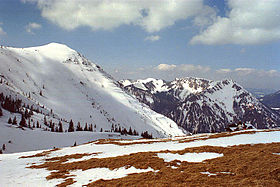Mangfallgebirge
| Mangfall Mountains | |
|---|---|

|
|
| Highest point | |
| Peak | Rotwand |
| Elevation | 1,884 m above NN |
| Dimensions | |
| Area | 752.40 km2 (290.50 sq mi) |
| Geography | |
| Country | Germany |
| State | Bavaria |
| Range coordinates | 47°39′03″N 11°56′07″E / 47.65083°N 11.93528°ECoordinates: 47°39′03″N 11°56′07″E / 47.65083°N 11.93528°E |
| Parent range | Bavarian Prealps |
The Mangfall Mountains (German: Mangfallgebirge), or sometimes Mangfall Alps, are the easternmost part of the Bavarian Prealps that, in turn, belong to the Northern Limestone Alps. The name comes from the River Mangfall, whose tributaries, the Rottach, Weißach, Schlierach and Leitzach, drain large parts of the area and form an important drinking water reservoir for the city of Munich.
The mountain region is bounded by the Isar valley in the west, the Inn valley in the east, the Brandenberg Alps (the Rofan) and the Austrian state border in the south. North of the Mangfalls lies the Alpine Foreland. The region has an area of 752.40 km² or, by narrower definitions, only 333 km².
The Mangfall Mountains are divided into the Tegernsee Mountains (from the Isar to the line Tegernsee−Rottach−Weiße Valepp), Schliersee Mountains (to the Leitzach valley) and the Wendelstein Group (between the Leitzach glacial valley and the Inn valley).
The highest peak in the Mangfalls is the Rotwand at 1.884 m above sea level (NN), one of the most popular local mountains for Munich's citizens at all times of the year. The Wendelstein lies a few kilometres further northeast of the Rotwand, but is separated from it by a valley. Another popular destination is the Brünnstein.
...
Wikipedia

